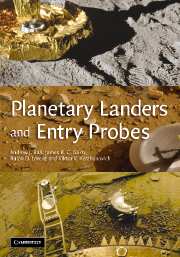Book contents
- Frontmatter
- Contents
- Preface
- Acknowledgements
- List of acronyms and abbreviations
- PART I Engineering issues specific to entry probes, landers or penetrators
- 1 Mission goals and system engineering
- 2 Accommodation, launch, cruise and arrival from orbit or interplanetary trajectory
- 3 Entering atmospheres
- 4 Descent through an atmosphere
- 5 Descent to an airless body
- 6 Planetary balloons, aircraft, submarines and cryobots
- 7 Arrival at a surface
- 8 Thermal control of landers and entry probes
- 9 Power systems
- 10 Communication and tracking of entry probes
- 11 Radiation environment
- 12 Surface activities: arms, drills, moles and mobility
- 13 Structures
- 14 Contamination of spacecraft and planets
- PART II Previous atmosphere/surface vehicles and their payloads
- PART III Case studies
- Appendix Some key parameters for bodies in the Solar System
- Bibliography
- References
- Index
14 - Contamination of spacecraft and planets
Published online by Cambridge University Press: 12 August 2009
- Frontmatter
- Contents
- Preface
- Acknowledgements
- List of acronyms and abbreviations
- PART I Engineering issues specific to entry probes, landers or penetrators
- 1 Mission goals and system engineering
- 2 Accommodation, launch, cruise and arrival from orbit or interplanetary trajectory
- 3 Entering atmospheres
- 4 Descent through an atmosphere
- 5 Descent to an airless body
- 6 Planetary balloons, aircraft, submarines and cryobots
- 7 Arrival at a surface
- 8 Thermal control of landers and entry probes
- 9 Power systems
- 10 Communication and tracking of entry probes
- 11 Radiation environment
- 12 Surface activities: arms, drills, moles and mobility
- 13 Structures
- 14 Contamination of spacecraft and planets
- PART II Previous atmosphere/surface vehicles and their payloads
- PART III Case studies
- Appendix Some key parameters for bodies in the Solar System
- Bibliography
- References
- Index
Summary
The transfer of material that is not native to a planet has been happening over the history of the Solar System, with meteorite delivery being a common example of this interchange. With the development of rocket launchers capable of injecting objects into interplanetary trajectories, mankind joined Nature in being able to alter another planet's composition. Generally spacecraft and their associated hardware are designed and assembled so as to minimize the amount of debris that they carry. This chapter examines the problems associated with the unintentional delivery of living or dead organic matter to celestial bodies; so-called ‘forward contamination’. The topic is often referred to by the phrase planetary protection, and its scope includes not only the possible contamination of planetary bodies, but also the potential introduction to the Earth of materal from a non-terrestrial biosphere. Furthermore, the threat that planetary protection seeks to minimize is not restricted to the introduction of non-native organisms to another planetary body. Non-living material, such as DNA fragments and other complex bio-relevant molecules might trigger false-positives from equipment designed to detect extant or extinct life.
A practical definition of a living entity might be that the agent processes matter and energy in such a way that it can reproduce, and in doing so prosper in the face of environmental stresses. If the environment of the organism changes too radically then the organism may be killed or rendered dormant.
- Type
- Chapter
- Information
- Planetary Landers and Entry Probes , pp. 132 - 146Publisher: Cambridge University PressPrint publication year: 2007

